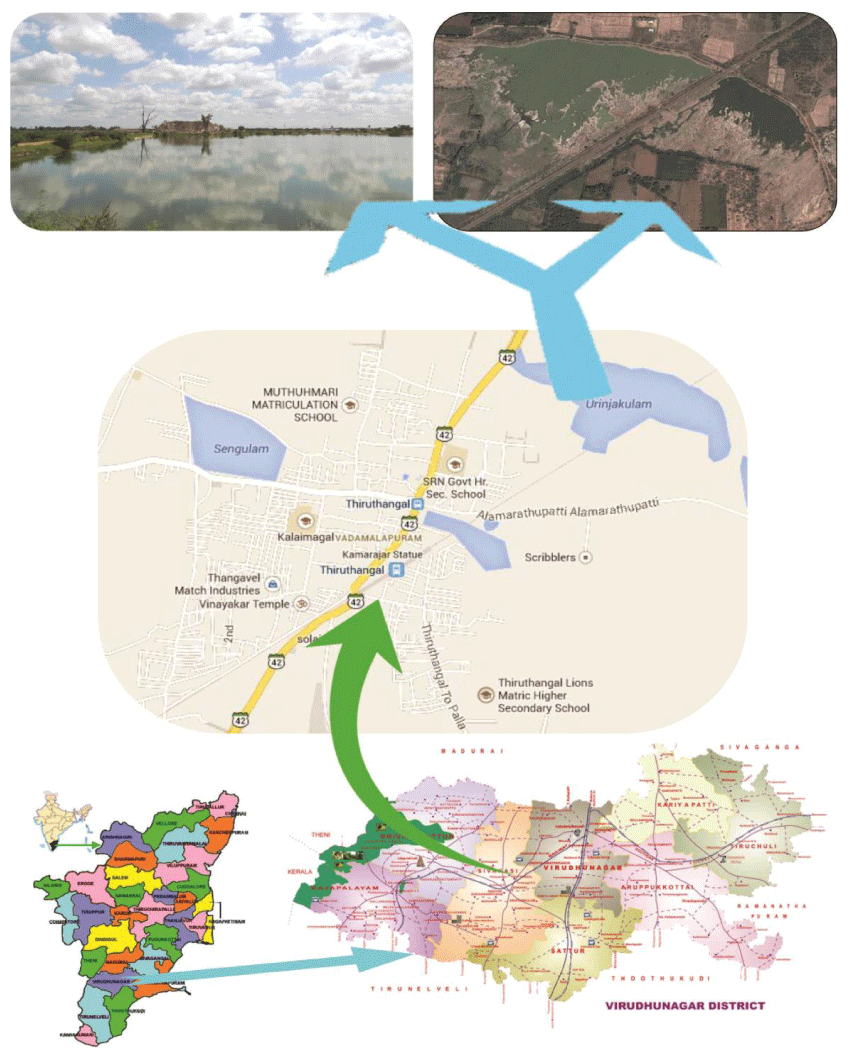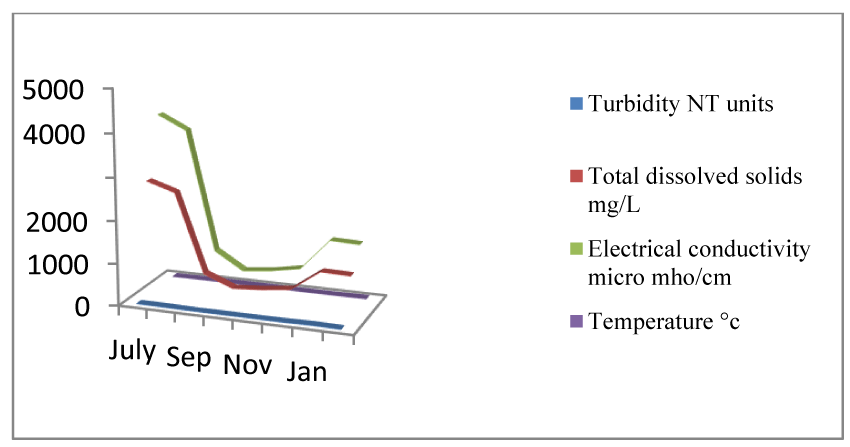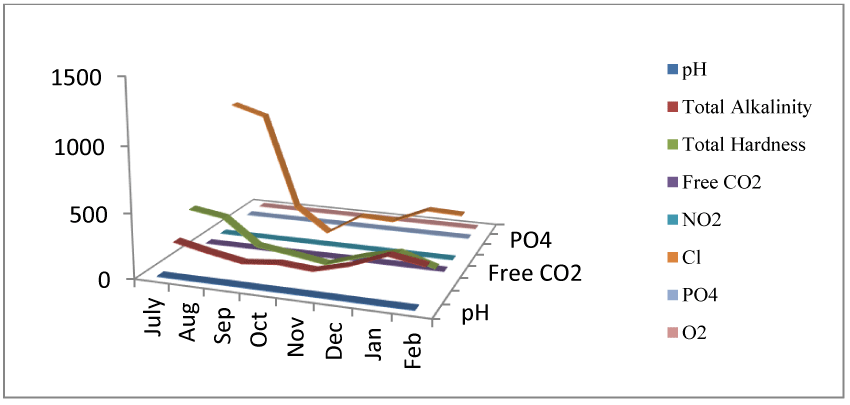International Journal of Aquaculture and Fishery Sciences
A study on physico-chemical parameters of Urinjikulam Pond, Thiruthangal (Virudhunagar District, Tamil Nadu)
J Arun Raj* and SP Sevarkodiyone
Cite this as
Raj JA, Sevarkodiyone SP (2018) A study on physico-chemical parameters of Urinjikulam Pond, Thiruthangal (Virudhunagar District, Tamil Nadu). Int J Aquac Fish Sci 4(1): 010-012. DOI: 10.17352/2455-8400.000036Present paper deals with the study of Physico-chemical parameters of Urinjikulam pond, Thiruthangal (Virudhunagar district, Tamil Nadu). Monthly variations in the physical and chemical parameters such as temperature, pH (7.5 to 8.8), dissolved oxygen (1.62-5.92 mg/L), total alkalinity (81-271mg/L), total hardness (48 to 364mg/L), chlorides (11 to 1030mg/L), Phosphate (0.36 to 2.86mg/L) and nitrate (0 to 0.40mg/L) were investigated. All the parameters were beyond the permissible limits.
Introduction
Present paper deals with the study of Physico-chemical parameters of Urinjikulam pond, Thiruthangal (Virudhunagar district, Tamil Nadu). Monthly variations in the physical and chemical parameters such as temperature, pH (7.5 to 8.8), dissolved oxygen (1.62-5.92 mg/L), total alkalinity (81-271mg/L), total hardness (48 to 364mg/L), chlorides (11 to 1030mg/L), Phosphate (0.36 to 2.86mg/L) and nitrate (0 to 0.40mg/L) were investigated. All the parameters were beyond the permissible limits.
Water is one of the most important and abundant compounds of the ecosystem. All living organisms on the earth need water for their survival and growth. As of now only earth is the planet having about 70 % of water. But due to increased human population, industrialization, use of fertilizers in the agriculture and man-made activity it is highly polluted with different harmful contaminants [1].
Pollution of water is measured by assessing the physiochemical parameters of water [2]. Physico-chemical analysis is the prime consideration to assess the quality of water for its best utilization like drinking, irrigation, fisheries, and industrial purpose and helpful in understanding the complex processes, interaction between the climatic and biological processes in the water [3].
The objective of the present study was to assess the ecosystem of Urinjikulam pond, Thiruthangal (Virudhunagar district, Tamil Nadu) by estimating the various physicochemical parameters like pH, Temperature, Total dissolved solids, Total Alkalinity, Total hardness, Phosphorus, Nitrate, Turbidity, Fluoride, chloride, Dissolved Oxygen, Ammonia, Iron, Turbidity and Conductivity.
Materials and Methods
Study area
The study area was Urinjikulam pond, Thiruthangal (Virudhunagar district, Tamil Nadu) it was located in Latitude: 9.4807463, Longitude: 77.8081363. Study was conducted from July2013 – February 2014. Water sample from pond was collected every month (Figure 1).
The Water samples were immediately brought in to Laboratory for the Estimation of various Physico- chemical parameters. The physical parameters such as temperature of air, water and pH were recorded by using Thermometer and Digital pH Meter (Systronics). The transparency of water to light was measured by using Secchi disc. The chemical parameters of water such as dissolved oxygen, total alkalinity, hardness, chlorides, sulphates and total dissolved solids etc. were determined by standard methods Were determined in the laboratory as per the standard method [4].
Result and Discussion
The data on physico-chemical analysis of Urinjikulam pond water has been given in table 1 and 2.
Physical parameters
Temperature: During the study period water temperature varied from 230±0.330C to 32°±0.560C. The maximum temperature (32°C) was observed during the month of September, 2013 and minimum temperature (23°C) was observed during the month of December, 2013. Jayabhaye et al. 2005, and Salve and Hiware, 2006 [3,5], observed that during summer, water temperature was high due to low water level and clear atmosphere.
Turbidity: The turbidity ranged from 3.1-19.5 NT units. The maximum value (19.5 NT units) observed during the month of January, 2014 and minimum value (3.1NT units) was observed during the month of September, 2013. Similar result was observed by Manjare et al. 2010 [6], turbidity of water fluctuated from 0.41± 0.02 NTU to 3.51 ± 0.72 NTU.
Total dissolved solids [TDS]: During the present study, the TDS wavered from 403 mg/L to 2740 mg/L. The higher value of total dissolved solids found in the month of July (2740 mg/L) and lower value found during the month of October (403 mg/L). Alaka 2014 [7], reported that the amount of total dissolved solids detected from water sample at Borgaon was 347.16 mg/L to 738.0 mg/L.
Electrical Conductivity [EC]: The electrical conductivity in the water of the pond analyzed during the study period has been found to be fluctuating between 611 and 4152 mho/cm. Kashyap 2016 [8], analyzed the Ramnai (Rewa Rural) drinking water for EC and reported that 180 mho/cm (Figure 2).
Chemical parameters
pH: During the present investigation, the pH of the water sample ranged from 7.5 in the month of August, 2013 to 8.8 in the month of September, 2013. This range indicates that the water is alkaline in nature. Similar finding was observed by Joshi et al. 2009 [9], pH of the Ganga River at Haridwar was slightly alkaline. It ranged from 7.06 to 8.35.
Dissolved oxygen: The dissolved oxygen value was ranged from 1.62-5.92 mg/L. Meme et al. 2014 [10], reported the range of dissolved oxygen was 6.02 to 7.01 mg/l at Oinyi River, Nigeria.
Free carbon dioxide: The free carbon dioxide value was ranged from 0.98-4.34 mg/L. Lendhe and Yergi, 2004 [11], observed free carbon dioxide between 1.76 to 4.84 at Phirange Kharbav lake of Thane district, Maharastra (Figure 3).
Total alkalinity: During present investigation the total alkalinity of the pond was ranged from 81-271mg/L. Manjare et al. 2010 [6], reported that the total alkalinity ranges from 148.33 ± 0.94 mg/l to 210 ± 1.00mg/l in Vadgaon tank of Kolhapur.
Total hardness: In the present study the total hardness of the water in the pond ranged from 48 to 364mg/L. Harney et al. 2012 [12], reported that the total hardness in Kanhala pond, Chandrapur was 86.50 to 168.00 mg/L.
Chloride: The chloride value ranged from 11 to 1030mg/L. Lubal et al. 2012 [13], investigated in Mhaswad water reservoir, Maharashtra the chloride was ranged between 49 mg/L to 80 mg/L.
Phosphate: In the present investigation the range of phosphate content was 0.36 to 2.86mg/L. Joshi et al., 2009 [9], reported the total phosphate was highest in monsoon season (0.23mg/l) and lowest in winter season (0.037mg/l) at Ganga river.
Nitrate: Nitrate content in the water ranged from 0 to 0.40mg/L. The highest nitrate value (0.40mg/L) was recorded during the month of December, 2013 and absent during the month of September, 2013. Simpi et al. 2011 [1], reported that the values of nitrate ranges from 2.1 mg/l to 12.8 mg/l in Hosahalli Tank, Karnataka.
Conclusion
A study of Physico-chemical parameters of Urinjikulam pond, Thiruthangal (Virudhunagar district, Tamil Nadu) was carried out by taking convinced important parameters like temperature, pH, dissolved oxygen, total alkalinity, total hardness, chlorides, phosphate, etc., for a period of July 2013 to February 2014. In present investigation pH, total alkalinity, total hardness, chlorine etc., were beyond the permissible limit. So, the Urinjikulam pond water considered as polluted water. The physico-chemical characteristics of Urinjikulam pond water suggested that there was harmful to pisiculture, irrigation and drinking water.
Authors wish to thank Management and Principal, Ayya Nadar Janaki Ammal College (Autonomous), Sivakasi for providing facilities to carry out this research work.
- Simpi B, Hiremath SM, Murthy KNS, Chandrashekarappa KN, Patel AN et al. (2011) Analysis of Water Quality Using Physico-Chemical Parameters Hosahalli Tank in Shimoga District, Karnataka, India. Global Journal of Science Frontier Research 11: 31-34. Link: https://goo.gl/cSif9y
- Wankhade V, Manwar N, Malu A, (2012) Evaluation of status of ecosystem of Sawanga (Vithoba) Lake (Malkhed Talav), District Amravati, Maharashtra by assessment of Some Physicochemical Characteristics of water. International Journal of Scientific and Research Publications 2: 1-10. Link: https://goo.gl/WYWTXY
- Salve BS, Hiware CJ (2006) Studies on water quality of Wanparkalpa reservoir, Nagapur, Near Parli Vaijinath, Dist Beed, Marathwada region. J Aqua Bio 21: 113- 117.
- APHA (2005) Standard methods of examination of water and waste water. American public health association. 19th ed. Inc. New York: 1170.
- Jayabhaye UM, Pentewar MS, Hiware CJ (2006) A study on physicochemical parameters of a minor reservoir, Sawana, Hingoli district, Maharashtra.
- Joshi DM, Kumar A, Agrawal N (2009) Studies on physicochemical parameters to assess the water quality of river Ganga for drinking purpose in Haridwar district. Rasayan J. Chem 2: 195-203. Link: https://goo.gl/HVmjin
- Manjare SA, Vhanalakar SA, Muley DV (2010) Water quality assessment of Vadgaon tank of Kolhapur (Maharashtra), with special reference to zooplankton. International Journal of Advanced Biotechnology and Research 1: 91-95. Link: https://goo.gl/KdCLxV
- Harney NV, Dhamani AA, Andrew RJ (2012) Phycio- cchemical status of three water bodies near Bhadrawati Town, Distt. Chandrapur, (M. S), India.Bionano Frontier. Eco Revolution, Colombo, Srilanka.
- Lubal MJ, Sutar AU, Pawar KW (2012) Studies on Physico-chemical aspects of Mhaswad water reservoir of Satara District (Maharashtra) India. IJPAES 2: 12-15. Link: https://goo.gl/7QEVgZ
- Kashyap VR (2016) Physico-chemical analysis of various water samples of Rewa district (M.P.) India. International Journal of Applied Research 2: 311-313. Link: https://goo.gl/Cvom7P
- Lende RS, Yergi SG (2004) Physico-chemical parameters and zooplankton diversity of Phirange Kharbav lake, Thane, Maharahtra. J Aqua Biol 19: 49-52.
- Meme FK, Arimoro FO, Nwadukwe FO (2014) Analyses of Physical and Chemical Parameters in Surface Waters nearby a Cement Factory in North Central, Nigeria. Journal of Environmental Protection 5: 826-834. Link: https://goo.gl/Y5m9eC
- Alaka PA (2014) An Assessment of Water Quality of Borgaon Reservoir in Sangli District of Maharashtra, India. International Research Journal of Environment Sciences 3: 48-53. Link: https://goo.gl/nGx476

Article Alerts
Subscribe to our articles alerts and stay tuned.
 This work is licensed under a Creative Commons Attribution 4.0 International License.
This work is licensed under a Creative Commons Attribution 4.0 International License.



 Save to Mendeley
Save to Mendeley
